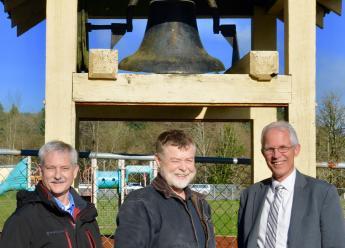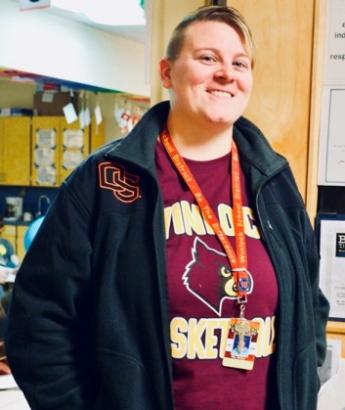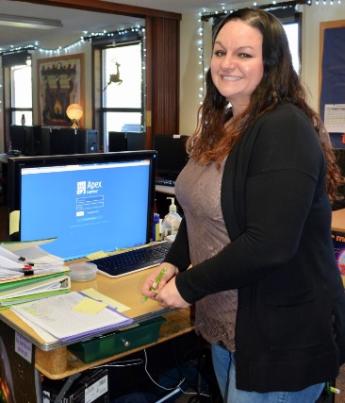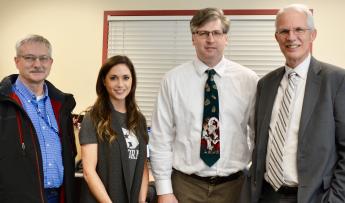GSA transforms e-waste into opportunity for rural school children

The new year dawned much brighter for students and teachers in the Winlock School District thanks to General Services Administration (GSA) and the GSA Computer for Learning (CFL) program. GSA’s information technology (IT) donation to the tiny rural Washington State school district completely revamped their IT capability right before Christmas, when the Winlock janitor packed his truck like Santa’s sleigh to transport an estimated $130,000 of equipment from the GSA Northwest/Arctic Region’s Headquarters in Auburn, Washington.
The donation of 234 items included 30 Dell laptops, 50 monitors (17 to 21 inches), antennas to increase wifi performance, and other peripheral IT equipment identified as excess by the Region’s Office of Information Technology. GSA’s Regional CFL Coordinator Greg Klein, a passionate supporter of the program, likes to see the useful life of these technology assets extended. “The best part of my job is that I know these products will be put to good use, and I love seeing our tax dollars help small communities.”

With roughly 700 students in grades K-12 the Winlock School District—where almost 80 percent of students live in poverty—never has had a line item in their budget for technology. They depend largely on grants and donations—which come few and far between. According to District Superintendent Rick Serns, of more than 295 districts in Washington State, 200 have student populations of less than 2,000 kids. “These smaller districts rely heavily on programs like CFL to meet their technology needs,” said Serns. “This equipment has the power to transform our students’ educational opportunities,” he elaborated.
Currently the ratio of students to computers is very high, but has not been tracked. “It’s not realistic at this point, but it would be ideal to have one computer for every two students… and the closer we can get to one computer for each student the better,” Serns shared.
So how will the donation improve the learning experience for the students? Kindergarten Teacher Carmen Parkison has already put the laptops in use to help her class develop basic reading and math skills. The portability of the laptops allow each of her kids to study enriching curriculum a half hour each day in a quieter space in the room where the kids can concentrate better. “The coursework in basic skills has the potential to help my kids independently leap ahead to the second grade level in math, reading, and other skills,” said Parkison.

In a day when we imagine each child has a smart phone and ipad, the reality for rural kids is much more grim. For some of the kids, the only exposure they will have to technology is at school. “These laptops and modern flat screen monitors will shoot these kids into the future by helping develop many of the keying and navigational skills the rest of us take for granted,” commented Tori Nelson, the Technology Coordinator for the elementary school. “All State tests are done online now. The knowledge these kids gain, even with basic navigation, will help them to be more successful in testing,” she added.
The wifi and other IT equipment will further improve the testing environment for state and college sponsored tests. High School and Middle School Assistant Principal Dennis Tauscher related that last year during state required testing week, student load exceeded the capacity of the antennas causing the wireless network to crash.

Another advantage the upgraded technology will bring to students of the Winolequa Learning Academy, the District’s alternative school, is continuity and a consistent learning environment. The GSA-donated equipment will effectively cut out 30 percent of operating malfunction issues previously experienced with the antiquated equipment they had. Teacher Danielle Craig related, “When a technology asset is out of service, it highly impacts classroom learning… especially because all of our coursework is accessed online through the APEX Learning System.”
Perhaps the most universal benefit will be the portability the new laptops will bring to learning. According to the District’s Technology Consultant for IT Support Rusty Henthorn, most of the current computer labs throughout the school complex feature 7 to 10-year-old desktop units in closed rooms. With the new laptops, the students will gain freedom to open up their learning horizons. Students may spend more time in the classroom with teachers, break down into smaller working groups to collaborate on projects, travel outside around the campus to record real-time field data for science projects, work one-on-one with teachers, and study independently in the school library.

High School Business & Technology Teacher Megan Evander will appreciate the 17 and 21 inch monitors that will replace the 13 inch monitors they have now. She shared that her kids will more successfully accomplish spreadsheet work that relates to real-world business practices and participate more successfully in entrepreneurship programs that mirror the business reality show “Shark Tank.”
The CFL program evolved as a guide for implementing Clinton-era Executive Order 12999 [PDF], “Educational Technology: Ensuring Opportunity for all Children in the Next Century.” The executive order encourages agencies, to the extent permitted by law, to transfer computers and related peripheral equipment excess to their needs directly to schools and some educational nonprofit organizations. The CFL program’s ambitious goal is to make modern computer technology an integral part of every classroom so that every child has the opportunity to be educated to his or her full potential. The GSA NW/Arctic Region Program ensures the recipients go through a rigorous vetting process to make sure they qualify for the equipment.
What would happen to this equipment if no CFL program existed? According to CFL Coordinator Greg Klein, “It would be excessed as e-waste.” In fact, Klein related how he once watched a junk dealer at a GSA auction pay only $250 to haul away a pallet of equipment valued at $11,200. The students and staff of the Winlock School District will tell anyone ready to hear that the equipment donated to them is definitely not junk, but their treasure.

 U.S. General Services Administration
U.S. General Services Administration